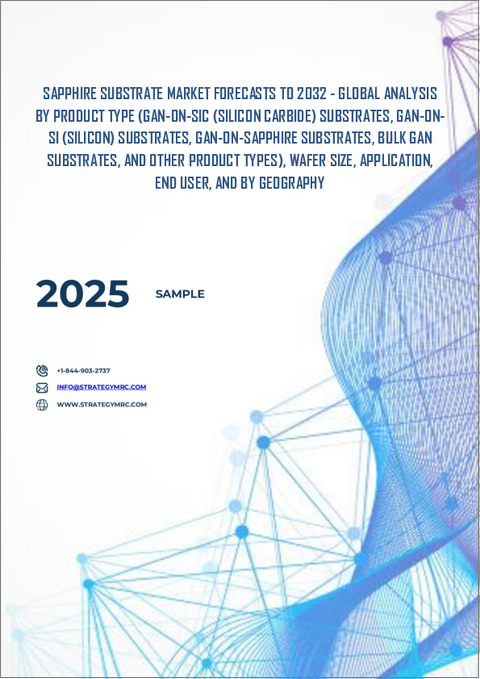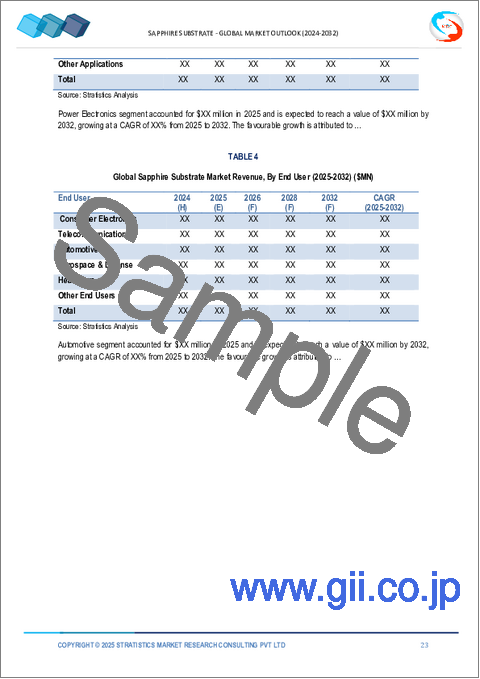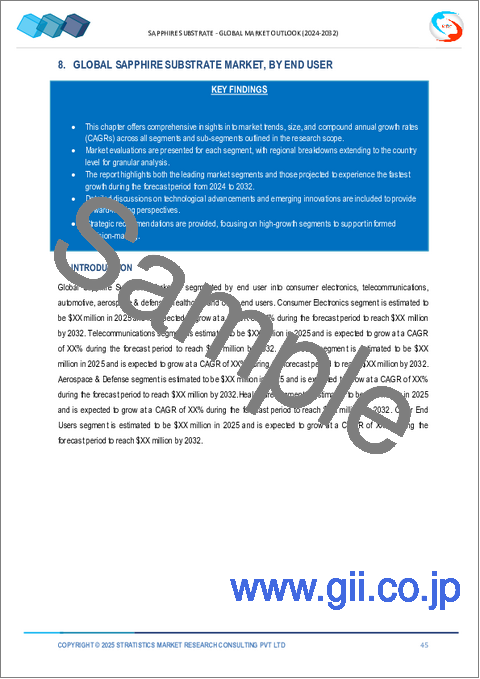|
|
市場調査レポート
商品コード
1734837
サファイア基板市場の2032年までの予測:製品タイプ別、ウエハーサイズ別、用途別、エンドユーザー別、地域別の世界分析Sapphire Substrate Market Forecasts to 2032 - Global Analysis By Product Type (GaN-on-SiC Substrates, GaN-on-Si Substrates, GaN-on-Sapphire Substrates, Bulk GaN Substrates, and Other Product Types), Wafer Size, Application, End User, and By Geography |
||||||
カスタマイズ可能
|
|||||||
| サファイア基板市場の2032年までの予測:製品タイプ別、ウエハーサイズ別、用途別、エンドユーザー別、地域別の世界分析 |
|
出版日: 2025年05月03日
発行: Stratistics Market Research Consulting
ページ情報: 英文 200+ Pages
納期: 2~3営業日
|
全表示
- 概要
- 図表
- 目次
Stratistics MRCによると、サファイア基板の世界市場は2025年に7億9,580万米ドルを占め、予測期間中のCAGRは7.6%で、2032年までには13億2,890万米ドルに達する見込みです。
サファイア基板は、LED、半導体デバイス、光学部品のベースとして使用される合成結晶性酸化アルミニウム(Al2O3)ウエハーです。その卓越した硬度、熱伝導性、UV/IR光に対する透明性は、高性能電子機器に理想的です。サファイア基板は、GaNベースのLED、RFチップ、レーザーダイオードの耐久性と効率を高めます。その極限条件への耐性は、航空宇宙、防衛、コンシューマーエレクトロニクスのアプリケーションをサポートし、長期的な信頼性を保証します。
米国半導体工業会のデータによると、高性能半導体デバイスへのニーズの高まりにより、サファイアウエハー市場は毎年9%以上の成長が見込まれています。
LED産業の成長
LED産業の拡大は、その優れた熱的・光学的特性により、サファイア基板の需要を促進しています。照明やディスプレイ用途でのLED採用の増加が市場成長を後押ししています。エネルギー効率規制がLEDの利用を促進し、基板需要を押し上げています。サファイア製造における技術革新により、サファイア基板製造の品質とコスト効率が向上します。エネルギー効率の高い照明に対する政府の優遇措置が市場拡大を後押し持続可能な照明ソリューションへの注目が市場成長を促進します。
代替材料との競合
LEDやパワーエレクトロニクスの用途では、炭化ケイ素や窒化ガリウムなどの代替材料がサファイア基板と競合しています。これらの材料は特定の用途においてコスト面で有利であり、サファイアの採用を制限しています。代替基板技術の課題が市場シェアに課題しています。サファイア基板の製造コストの高さが小規模メーカーの足かせとなっています。サファイアの長期的な利点に関する認識不足が成長を妨げます。新興市場におけるコスト効率の高い基板へのシフトが拡張性を制限します。
5Gインフラの拡大
5Gインフラの展開は、RFデバイスやパワーエレクトロニクスにサファイア基板の需要を生み出しています。サファイアの高い熱伝導性と耐久性は、5Gアプリケーションに理想的です。通信インフラへの投資拡大が市場機会を促進します。基板メーカーと5G企業とのパートナーシップがイノベーションを促進します。高速ネットワークへの規制支援が投資を促進します。小型で効率的なデバイスへの動向が基板需要を押し上げます。
知的財産の課題
サファイア基板の製造工程をめぐる知的財産権紛争は、法的・財務的リスクを生みます。特許侵害は製品の発売を遅らせ、コストを増加させます。複雑なライセンシング契約は、新規参入企業の市場参入を複雑にします。一部の地域では標準化された知的財産権の枠組みがないため、成長が阻害されます。高い訴訟費用が中小メーカーに負担をかけます。市場競争における技術盗用のリスクが課題を増やします。これらの問題は、サファイア基板市場の安定性を脅かします。
COVID-19の影響:
COVID-19の大流行により、サプライチェーンの遅延と工場閉鎖によりサファイア基板の生産が中断されました。操業停止中のLED需要の減少は市場成長に影響を与えました。しかし、エレクトロニクスと5G分野の回復が基板需要を押し上げました。労働力不足と物流の課題が製造工程に支障をきたしました。原材料費の高騰は値ごろ感に影響しました。パンデミックは5Gインフラへの投資を加速させ、市場の回復を促しました。
GaN-on-SiC(炭化ケイ素)基板セグメントが予測期間中最大になる見込み
GaN-on-SiC(炭化ケイ素)基板セグメントは、高性能RFおよびパワーエレクトロニクスアプリケーションにおける重要な役割に後押しされ、予測期間中最大の市場シェアを占めると予想されます。GaN-on-SiCは熱伝導性に優れており、5Gや自動車分野での採用を促進しています。基板製造の進歩は効率と信頼性を高めます。高周波デバイスの増加がセグメントの成長を支えています。GaN-on-SiCの規制認可が市場の信頼を確保します。これらの基板は産業全般にわたって汎用性があるため、市場シェアが強化されます。
予測期間中、パワーエレクトロニクス分野のCAGRが最も高くなる見込み
予測期間中、パワーエレクトロニクス分野は、自動車や再生可能エネルギーにおける効率的でコンパクトなデバイスの需要増加に牽引され、最も高い成長率を記録すると予測されています。サファイア基板は高性能パワーモジュールを可能にし、採用を後押しします。電気自動車生産台数の増加がセグメント拡大の原動力となります。基板設計の革新が熱管理を改善します。エレクトロニクス企業との提携が技術進歩を促進します。持続可能なエネルギーソリューションへの注目が成長を支えます。
最もシェアが高い地域:
予測期間中、アジア太平洋は、中国や韓国のような国々におけるLEDおよびエレクトロニクス産業の優位性により、最大の市場シェアを占めると予想されます。5Gインフラへの投資が基板需要を牽引エネルギー効率の高い技術に対する政府の支援が市場成長を強化します。主要基板メーカーの存在が地域的優位性を高めます。高度なディスプレイに対する消費者需要の高まりと産業オートメーションへの注力により、採用が拡大を後押しします。
CAGRが最も高い地域:
予測期間中、北米地域は5Gとパワーエレクトロニクスアプリケーションへの旺盛な投資により、最も高いCAGRを示すと予測されます。同地域の先進的な研究開発エコシステムは、基板技術の革新を促進します。エネルギー効率に対する規制支援が採用を後押しします。主要エレクトロニクス企業の存在が市場成長を促進します。電気自動車需要の高まりが拡大を後押しします。ハイテク企業との提携が製品開発を促進します。高性能デバイスの動向が需要を加速します。
無料カスタマイズサービス:
本レポートをご購読のお客様には、以下の無料カスタマイズオプションのいずれかをご利用いただけます:
- 企業プロファイル
- 追加市場プレーヤーの包括的プロファイリング(3社まで)
- 主要企業のSWOT分析(3社まで)
- 地域セグメンテーション
- 顧客の関心に応じた主要国の市場推計・予測・CAGR(注:フィージビリティチェックによる)
- 競合ベンチマーキング
- 製品ポートフォリオ、地理的プレゼンス、戦略的提携に基づく主要企業のベンチマーキング
目次
第1章 エグゼクティブサマリー
第2章 序文
- 概要
- ステークホルダー
- 調査範囲
- 調査手法
- データマイニング
- データ分析
- データ検証
- 調査アプローチ
- 調査情報源
- 1次調査情報源
- 2次調査情報源
- 前提条件
第3章 市場動向分析
- 促進要因
- 抑制要因
- 機会
- 脅威
- 製品分析
- 用途分析
- エンドユーザー分析
- 新興市場
- COVID-19の影響
第4章 ポーターのファイブフォース分析
- 供給企業の交渉力
- 買い手の交渉力
- 代替品の脅威
- 新規参入業者の脅威
- 競争企業間の敵対関係
第5章 世界のサファイア基板市場:製品タイプ別
- GaN-on-SiC(シリコンカーバイド)基板
- GaN-on-Si(シリコン)基板
- GaN-on-サファイア基板
- バルクGaN基板
- その他の製品タイプ
第6章 世界のサファイア基板市場:ウエハーサイズ別
- 2インチのウエハー
- 4インチのウエハー
- 6インチのウエハー
- 8インチ以上のウエハー
第7章 世界のサファイア基板市場:用途別
- LED
- パワーエレクトロニクス
- 無線周波数(RF)デバイス
- レーザーダイオード
- 光検出器
- その他の用途
第8章 世界のサファイア基板市場:エンドユーザー別
- コンシューマーエレクトロニクス
- 通信
- 自動車
- 航空宇宙・防衛
- ヘルスケア
- その他のエンドユーザー
第9章 世界のサファイア基板市場:地域別
- 北米
- 米国
- カナダ
- メキシコ
- 欧州
- ドイツ
- 英国
- イタリア
- フランス
- スペイン
- その他欧州
- アジア太平洋
- 日本
- 中国
- インド
- オーストラリア
- ニュージーランド
- 韓国
- その他アジア太平洋
- 南米
- アルゼンチン
- ブラジル
- チリ
- その他南米
- 中東・アフリカ
- サウジアラビア
- アラブ首長国連邦
- カタール
- 南アフリカ
- その他中東・アフリカ
第10章 主な発展
- 契約、パートナーシップ、コラボレーション、ジョイントベンチャー
- 買収と合併
- 新製品発売
- 事業拡大
- その他の主要戦略
第11章 企業プロファイリング
- Rubicon
- Monocrystal
- Acme Electronics
- Kyocera
- Namiki Precision Jewel
- Astek
- Saint-Gobain
- Hansol LCD
- LG Siltron
- Korea Daegu
- Tera Xtal Technology
- Crystal Applied Technology
- Procrystal Technology
- Crystalwise Technology
- Wafer Works
List of Tables
- Table 1 Global Sapphire Substrate Market Outlook, By Region (2024-2032) ($MN)
- Table 2 Global Sapphire Substrate Market Outlook, By Product Type (2024-2032) ($MN)
- Table 3 Global Sapphire Substrate Market Outlook, By GaN-on-SiC (Silicon Carbide) Substrates (2024-2032) ($MN)
- Table 4 Global Sapphire Substrate Market Outlook, By GaN-on-Si (Silicon) Substrates (2024-2032) ($MN)
- Table 5 Global Sapphire Substrate Market Outlook, By GaN-on-Sapphire Substrates (2024-2032) ($MN)
- Table 6 Global Sapphire Substrate Market Outlook, By Bulk GaN Substrates (2024-2032) ($MN)
- Table 7 Global Sapphire Substrate Market Outlook, By Other Product Types (2024-2032) ($MN)
- Table 8 Global Sapphire Substrate Market Outlook, By Wafer Size (2024-2032) ($MN)
- Table 9 Global Sapphire Substrate Market Outlook, By 2-inch Wafers (2024-2032) ($MN)
- Table 10 Global Sapphire Substrate Market Outlook, By 4-inch Wafers (2024-2032) ($MN)
- Table 11 Global Sapphire Substrate Market Outlook, By 6-inch Wafers (2024-2032) ($MN)
- Table 12 Global Sapphire Substrate Market Outlook, By 8-inch Wafers And Above (2024-2032) ($MN)
- Table 13 Global Sapphire Substrate Market Outlook, By Application (2024-2032) ($MN)
- Table 14 Global Sapphire Substrate Market Outlook, By LEDs (2024-2032) ($MN)
- Table 15 Global Sapphire Substrate Market Outlook, By Power Electronics (2024-2032) ($MN)
- Table 16 Global Sapphire Substrate Market Outlook, By Radio Frequency (RF) Devices (2024-2032) ($MN)
- Table 17 Global Sapphire Substrate Market Outlook, By Laser Diodes (2024-2032) ($MN)
- Table 18 Global Sapphire Substrate Market Outlook, By Photodetectors (2024-2032) ($MN)
- Table 19 Global Sapphire Substrate Market Outlook, By Other Applications (2024-2032) ($MN)
- Table 20 Global Sapphire Substrate Market Outlook, By End User (2024-2032) ($MN)
- Table 21 Global Sapphire Substrate Market Outlook, By Consumer Electronics (2024-2032) ($MN)
- Table 22 Global Sapphire Substrate Market Outlook, By Telecommunications (2024-2032) ($MN)
- Table 23 Global Sapphire Substrate Market Outlook, By Automotive (2024-2032) ($MN)
- Table 24 Global Sapphire Substrate Market Outlook, By Aerospace & Defense (2024-2032) ($MN)
- Table 25 Global Sapphire Substrate Market Outlook, By Healthcare (2024-2032) ($MN)
- Table 26 Global Sapphire Substrate Market Outlook, By Other End Users (2024-2032) ($MN)
Note: Tables for North America, Europe, APAC, South America, and Middle East & Africa Regions are also represented in the same manner as above.
According to Stratistics MRC, the Global Sapphire Substrate Market is accounted for $795.8 million in 2025 and is expected to reach $1328.9 million by 2032 growing at a CAGR of 7.6% during the forecast period. Sapphire Substrate is a synthetic crystalline aluminum oxide (Al2O3) wafer used as a base for LEDs, semiconductor devices, and optical components. Its exceptional hardness, thermal conductivity, and transparency to UV/IR light make it ideal for high-performance electronics. Sapphire substrates enhance the durability and efficiency of GaN-based LEDs, RF chips, and laser diodes. Their resistance to extreme conditions supports applications in aerospace, defense, and consumer electronics, ensuring long-term reliability.
According to data from the U.S. Semiconductor Industry Association, the sapphire wafer market is expected to grow by over 9% annually, driven by the increasing need for high-performance semiconductor devices.
Market Dynamics:
Driver:
Growing LED industry
The expanding LED industry is driving demand for sapphire substrates due to their superior thermal and optical properties. Rising adoption of LEDs in lighting and display applications fuels market growth. Energy efficiency regulations promote LED usage, boosting substrate demand. Innovations in sapphire manufacturing sapphire substrate production enhance quality and cost-effectiveness. Government incentives for energy-efficient lighting support market expansion. The focus on sustainable lighting solutions propels market growth.
Restraint:
Competition from alternative materials
Alternative materials, such as silicon carbide and gallium nitride, compete with sapphire substrates in LED and power electronics applications. These materials offer cost advantages in certain applications, limiting sapphire adoption. Advances in alternative substrate technologies challenge market share. High production costs for sapphire substrates deter small-scale manufacturers. Lack of awareness about sapphire's long-term benefits hinders growth. The shift toward cost-effective substrates in emerging markets restricts scalability.
Opportunity:
Expansion in 5G infrastructure
The rollout of 5G infrastructure is creating demand for sapphire substrates in RF devices and power electronics. Sapphire's high thermal conductivity and durability make it ideal for 5G applications. Growing investments in telecom infrastructure drive market opportunities. Partnerships between substrate manufacturers and 5G firms foster innovation. Regulatory support for high-speed networks encourages investment. The trend toward compact and efficient devices boosts substrate demand.
Threat:
Intellectual property challenges
Intellectual property disputes over sapphire substrate production processes create legal and financial risks. Patent infringements can delay product launches and increase costs. Complex licensing agreements complicate market entry for new players. Lack of standardized IP frameworks in some regions hinders growth. High litigation costs strain smaller manufacturers. The risk of technology theft in competitive markets adds challenges. These issues threaten the stability of the sapphire substrate market.
Covid-19 Impact:
The COVID-19 pandemic disrupted sapphire substrate production due to supply chain delays and factory closures. Reduced demand for LEDs during lockdowns impacted market growth. However, the recovery of the electronics and 5G sectors boosted substrate demand. Labor shortages and logistics challenges hindered manufacturing processes. Rising raw material costs affected affordability. The pandemic accelerated investments in 5G infrastructure, driving market recovery.
The GaN-on-SiC (silicon carbide) Substrates segment is expected to be the largest during the forecast period
The GaN-on-SiC (silicon carbide) substrates segment is expected to account for the largest market share during the forecast period propelled by its critical role in high-performance RF and power electronics applications. GaN-on-SiC offers superior thermal conductivity, driving adoption in 5G and automotive sectors. Advances in substrate manufacturing enhance efficiency and reliability. The rise in high-frequency devices supports segment growth. Regulatory approvals for GaN-on-SiC ensure market trust. The versatility of these substrates across industries strengthens market share.
The power electronics segment is expected to have the highest CAGR during the forecast period
Over the forecast period, the power electronics segment is predicted to witness the highest growth rate driven by increasing demand for efficient and compact devices in automotive and renewable energy. Sapphire substrates enable high-performance power modules, boosting adoption. The rise in electric vehicle production fuels segment expansion. Innovations in substrate design improve thermal management. Partnerships with electronics firms drive technological advancements. The focus on sustainable energy solutions supports growth.
Region with largest share:
During the forecast period, the Asia Pacific region is expected to hold the largest market share owing to its dominant LED and electronics industries in countries like China and South Korea. High investments in 5G infrastructure drive substrate demand. Government support for energy-efficient technologies strengthens market growth. The presence of key substrate manufacturers enhances regional dominance. Rising consumer demand for advanced displays and focus on industrial automation supports adoption fuels expansion.
Region with highest CAGR:
Over the forecast period, the North America region is anticipated to exhibit the highest CAGR fueled by strong investments in 5G and power electronics applications. The region's advanced R&D ecosystem drives innovation in substrate technologies. Regulatory support for energy efficiency boosts adoption. The presence of leading electronics companies fosters market growth. Growing demand for electric vehicles supports expansion. Partnerships with tech firms drive product development. The trend of high-performance devices accelerates demand.
Key players in the market
Some of the key players in Sapphire Substrate Market include Rubicon, Monocrystal, Acme Electronics, Kyocera, Namiki Precision Jewel, Astek, Saint-Gobain, Hansol LCD, LG Siltron, Korea Daegu, Tera Xtal Technology, Crystal Applied Technology, Procrystal Technology, Crystalwise Technology, and Wafer Works.
Key Developments:
In March 2025, Monocrystal introduced patterned sapphire substrates (PSS) with nano-textured surfaces, boosting LED light extraction efficiency by 25% for next-gen micro-LED displays.
In February 2025, LG Siltron developed ultra-thin (100µm) flexible sapphire films for foldable smartphone screens, combining scratch resistance with bend durability up to 200,000 cycles.
In September 2023, Kyocera announced the development of larger-diameter sapphire substrates to meet increasing demand in LED displays and other applications, enhancing production efficiency and performance.
Product Types Covered:
- GaN-on-SiC (Silicon Carbide) Substrates
- GaN-on-Si (Silicon) Substrates
- GaN-on-Sapphire Substrates
- Bulk GaN Substrates
- Other Product Types
Wafer Sizes Covered:
- 2-inch Wafers
- 4-inch Wafers
- 6-inch Wafers
- 8-inch Wafers And Above
Applications Covered:
- LEDs
- Power Electronics
- Radio Frequency (RF) Devices
- Laser Diodes
- Photodetectors
- Other Applications
End Users Covered:
- Consumer Electronics
- Telecommunications
- Automotive
- Aerospace & Defense
- Healthcare
- Other End Users
Regions Covered:
- North America
- US
- Canada
- Mexico
- Europe
- Germany
- UK
- Italy
- France
- Spain
- Rest of Europe
- Asia Pacific
- Japan
- China
- India
- Australia
- New Zealand
- South Korea
- Rest of Asia Pacific
- South America
- Argentina
- Brazil
- Chile
- Rest of South America
- Middle East & Africa
- Saudi Arabia
- UAE
- Qatar
- South Africa
- Rest of Middle East & Africa
What our report offers:
- Market share assessments for the regional and country-level segments
- Strategic recommendations for the new entrants
- Covers Market data for the years 2024, 2025, 2026, 2028, and 2032
- Market Trends (Drivers, Constraints, Opportunities, Threats, Challenges, Investment Opportunities, and recommendations)
- Strategic recommendations in key business segments based on the market estimations
- Competitive landscaping mapping the key common trends
- Company profiling with detailed strategies, financials, and recent developments
- Supply chain trends mapping the latest technological advancements
Free Customization Offerings:
All the customers of this report will be entitled to receive one of the following free customization options:
- Company Profiling
- Comprehensive profiling of additional market players (up to 3)
- SWOT Analysis of key players (up to 3)
- Regional Segmentation
- Market estimations, Forecasts and CAGR of any prominent country as per the client's interest (Note: Depends on feasibility check)
- Competitive Benchmarking
- Benchmarking of key players based on product portfolio, geographical presence, and strategic alliances
Table of Contents
1 Executive Summary
2 Preface
- 2.1 Abstract
- 2.2 Stake Holders
- 2.3 Research Scope
- 2.4 Research Methodology
- 2.4.1 Data Mining
- 2.4.2 Data Analysis
- 2.4.3 Data Validation
- 2.4.4 Research Approach
- 2.5 Research Sources
- 2.5.1 Primary Research Sources
- 2.5.2 Secondary Research Sources
- 2.5.3 Assumptions
3 Market Trend Analysis
- 3.1 Introduction
- 3.2 Drivers
- 3.3 Restraints
- 3.4 Opportunities
- 3.5 Threats
- 3.6 Product Analysis
- 3.7 Application Analysis
- 3.8 End User Analysis
- 3.9 Emerging Markets
- 3.10 Impact of Covid-19
4 Porters Five Force Analysis
- 4.1 Bargaining power of suppliers
- 4.2 Bargaining power of buyers
- 4.3 Threat of substitutes
- 4.4 Threat of new entrants
- 4.5 Competitive rivalry
5 Global Sapphire Substrate Market, By Product Type
- 5.1 Introduction
- 5.2 GaN-on-SiC (Silicon Carbide) Substrates
- 5.3 GaN-on-Si (Silicon) Substrates
- 5.4 GaN-on-Sapphire Substrates
- 5.5 Bulk GaN Substrates
- 5.6 Other Product Types
6 Global Sapphire Substrate Market, By Wafer Size
- 6.1 Introduction
- 6.2 2-inch Wafers
- 6.3 4-inch Wafers
- 6.4 6-inch Wafers
- 6.5 8-inch Wafers And Above
7 Global Sapphire Substrate Market, By Application
- 7.1 Introduction
- 7.2 LEDs
- 7.3 Power Electronics
- 7.4 Radio Frequency (RF) Devices
- 7.5 Laser Diodes
- 7.6 Photodetectors
- 7.7 Other Applications
8 Global Sapphire Substrate Market, By End User
- 8.1 Introduction
- 8.2 Consumer Electronics
- 8.3 Telecommunications
- 8.4 Automotive
- 8.5 Aerospace & Defense
- 8.6 Healthcare
- 8.7 Other End Users
9 Global Sapphire Substrate Market, By Geography
- 9.1 Introduction
- 9.2 North America
- 9.2.1 US
- 9.2.2 Canada
- 9.2.3 Mexico
- 9.3 Europe
- 9.3.1 Germany
- 9.3.2 UK
- 9.3.3 Italy
- 9.3.4 France
- 9.3.5 Spain
- 9.3.6 Rest of Europe
- 9.4 Asia Pacific
- 9.4.1 Japan
- 9.4.2 China
- 9.4.3 India
- 9.4.4 Australia
- 9.4.5 New Zealand
- 9.4.6 South Korea
- 9.4.7 Rest of Asia Pacific
- 9.5 South America
- 9.5.1 Argentina
- 9.5.2 Brazil
- 9.5.3 Chile
- 9.5.4 Rest of South America
- 9.6 Middle East & Africa
- 9.6.1 Saudi Arabia
- 9.6.2 UAE
- 9.6.3 Qatar
- 9.6.4 South Africa
- 9.6.5 Rest of Middle East & Africa
10 Key Developments
- 10.1 Agreements, Partnerships, Collaborations and Joint Ventures
- 10.2 Acquisitions & Mergers
- 10.3 New Product Launch
- 10.4 Expansions
- 10.5 Other Key Strategies
11 Company Profiling
- 11.1 Rubicon
- 11.2 Monocrystal
- 11.3 Acme Electronics
- 11.4 Kyocera
- 11.5 Namiki Precision Jewel
- 11.6 Astek
- 11.7 Saint-Gobain
- 11.8 Hansol LCD
- 11.9 LG Siltron
- 11.10 Korea Daegu
- 11.11 Tera Xtal Technology
- 11.12 Crystal Applied Technology
- 11.13 Procrystal Technology
- 11.14 Crystalwise Technology
- 11.15 Wafer Works





